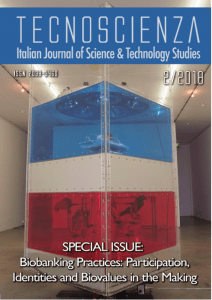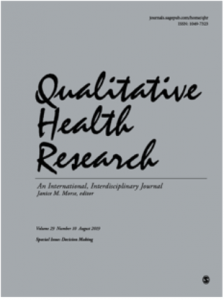Contours and Constraints of an Autism Genetic Database: Scientific, Social, and Digital Species of BiovalueTecnoscienza, 2019 This paper examines the scientific, social and digital processes that shape multiple forms of biovalue evident in the development, participation and use of the Simons Simplex Collection (SSC), the largest autism genetic databases in North America. Based on interviews with SSC study participants and investigators, as well as a content analysis of a range of SSC materials, this empirical study makes visible the various contours of biovalue that are entangled between scientists who use this data for autism research, families who donate their blood and medical information to gain access to needed resources, and digital networks of exchange that make hybrid connections between and among these emergent biosocial communities. By examining the production of and interactions between scientific, social and digital forms of biovalue this paper highlights the constraints embedded within this heterogeneous assemblage to offer a critical account of the limits of the SSC and subsequent knowledge production. I contend that while the multi-dimensionality of biovalue built into the fabric of the SSC structure creates various contours of biovalue, it structurally constrains the types of production and knowledge flows that are allowed to be conceived and generated. |
Autism Disparities: A Systematic Review and Meta-Ethnography of Qualitative ResearchQualitative Health Research, 2019
Racial, ethnic, and socioeconomic disparities associated with autism spectrum disorder (ASD) are evident across many service domains including access to early assessment, diagnosis, and therapeutic interventions. To better understand the complex social and structural factors contributing to these disparities, this article offers a systematic review of peer-reviewed qualitative research conducted from 2010 to 2016 in the United States that investigates autism disparities experienced by marginalized communities. Based on these criteria, we identified 24 qualitative research studies and conducted an analysis using meta-ethnography and an intersectional interpretive lens. We identified three interdependent themes contributing to autism disparities, including familial, cultural, and structural barriers. Omissions in the literature were also evident, including a lack of research on underserved adults with ASD and the gendered inequities of caregiving. We discuss the implications of our findings and offer new questions that take an intersectional approach using qualitative research to investigate autism disparities. |
Contextualizing the Social and Structural Constraints of Accessing Autism Services among Single Black Female CaregiversInternational Journal of Child Health and Human Development, 2019
|
Black Villages, Empathy and Collective Value: Principles that Guide an Intersectional Approach.Catalyst: Feminism, Theory, Technoscience 3(1). 2017 DOI: http://dx.doi.org/10.28968/cftt.v3i1
|
Multiple Autisms: Spectrums of Advocacy and Genomic ScienceUniversity of Minnesota Press, 2016.
|
Parenting Work and Autism Trajectories of CareSociology of Health and Illness, Volume 38(7), 2016See a virtual abstract of Parenting Work and Autism Trajectories of Care This study investigates the work and care associated with raising child with disabilities in the United States. Based on in-depth interviews with parents who have a child with autism, it develops the notion of parenting work and trajectories of care to investigate how parents navigate and coordinate the challenges of getting an autism diagnosis, obtaining educational services, and re-contextualizing the possibilities for the future. I argue that parents embody a complex mix of love, hope, and responsibility in parenting work and trajectories of care that expands temporal and social elements of illness work and illness trajectories initially developed by Anselm Strauss and colleagues. This type of parenting work changes over time and is influenced by social structural forces and relationships in which the care takes place. The re-articulation of these analytic tools also begins to untangle the intricate mix of both medical and social models of disability that parents embrace and continuously negotiate. This study demonstrates how parents accept the medical model of disability by seeking and pushing for a clinical autism diagnosis and subsequent treatments, while at the same time challenge the limits placed on their children by providing them opportunities, possible futures, and a sense of personhood. |
Vanishing Diagnosis of Asperger’s DisorderSociology of Diagnosis (Advances in Medical Sociology, Volume 12), 237-259, 2011.
Methodology/approach – This research is based on 19 interviews with adults diagnosed or self-diagnosed with AD. Central themes surrounding issues of identity and everyday life experiences were determined using grounded theory approaches. Findings – This study demonstrates how the diagnosis and self-diagnosis of AD is fused with individual identity. It also shows how Asperger identity is positively embraced. The proposed changes to eliminate AD in DSM-V threaten these assertions of Asperger identity, which could potentially enhance stigma experienced by people with AD. Regardless of its removal, Asperger identity must be considered within the broader context of people’s everyday lives and how experiences in social interaction and communication can be strong agents of identity construction. Social implications – The proposed changes to eliminate AD in DSM-V is a social issue that will impact individuals with Asperger’s and their families, as well as health-care professionals, health insurers, researchers, state agencies, and educational providers. Originality/value of paper – This chapter offers a unique insight into identity construction based on the diagnosis and self-diagnosis of AD. |
Narratives of Participation in Autism Genetics ResearchScience, Technology and Human Values, Published online before print July 3, 2014.
|
Trends in US Autism Research FundingJournal Autism and Developmental Disorder, 39(5), 788-795, 2009.T |
Interacting and paradoxical forces in neuroscience and societyNature Review Neuroscience, 8(February), 153-159, 2007.
|




 Is there a gene for autism? Despite a billion-dollar, twenty-year effort to find out—and the more elusive the answer, the greater the search seems to become—no single autism gene has been identified. In
Is there a gene for autism? Despite a billion-dollar, twenty-year effort to find out—and the more elusive the answer, the greater the search seems to become—no single autism gene has been identified. In 

 This article provides empirical evidence of the social context and moral reasoning embedded within a parents’ decision to participate in autism genetics research. Based on in-depth interviews of parents who donated their family’s blood and medical information to an autism genetic database, three narratives of participation are analyzed, including the altruistic parent, the obligated parent, and the diagnostic parent. Although parents in this study were not generally concerned with bioethical principles such as autonomy and the issues of informed consent and/or privacy and confidentiality of genetic information, a critical analysis reveals contextual bioethics embedded within these different narratives. These include the negotiations of responsibility that parents confront in biomedical research, the misguided hope and expectations parents place in genomic science, and the structural barriers of obtaining an autism diagnosis and educational services. Based on these findings, this article demonstrates the limits of a principle-based approach to bioethics and the emergent forms of biological citizenship that takes into account the social situations of people’s lives and the moral reasoning they negotiate when participating in autism genetic research.
This article provides empirical evidence of the social context and moral reasoning embedded within a parents’ decision to participate in autism genetics research. Based on in-depth interviews of parents who donated their family’s blood and medical information to an autism genetic database, three narratives of participation are analyzed, including the altruistic parent, the obligated parent, and the diagnostic parent. Although parents in this study were not generally concerned with bioethical principles such as autonomy and the issues of informed consent and/or privacy and confidentiality of genetic information, a critical analysis reveals contextual bioethics embedded within these different narratives. These include the negotiations of responsibility that parents confront in biomedical research, the misguided hope and expectations parents place in genomic science, and the structural barriers of obtaining an autism diagnosis and educational services. Based on these findings, this article demonstrates the limits of a principle-based approach to bioethics and the emergent forms of biological citizenship that takes into account the social situations of people’s lives and the moral reasoning they negotiate when participating in autism genetic research. his study shows that the number of autism research grants funded in the US from 1997 to 2006 significantly increased 15% per year. Although the majority of projects were concentrated in basic science (65%) compared to clinical (15%) and translational research (20%), there is a signific
his study shows that the number of autism research grants funded in the US from 1997 to 2006 significantly increased 15% per year. Although the majority of projects were concentrated in basic science (65%) compared to clinical (15%) and translational research (20%), there is a signific Discoveries in the field of neuroscience are a natural source of discourse among scientists and have long been disseminated to the public. Historically, as news of findings has travelled between communities, it has elicited both expected and unusual reactions. What scientific landmarks promote discourse within the professional community? Do the same findings achieve a place in the public eye? How does the media choose what is newsworthy, and why does the public react the way it does? Drawing on examples of past challenges at the crossroads of neuroscience and society and on a case study of trends in one neurogenetic disease, autism, we explore the dialectical forces interacting in scientific and public discourse.
Discoveries in the field of neuroscience are a natural source of discourse among scientists and have long been disseminated to the public. Historically, as news of findings has travelled between communities, it has elicited both expected and unusual reactions. What scientific landmarks promote discourse within the professional community? Do the same findings achieve a place in the public eye? How does the media choose what is newsworthy, and why does the public react the way it does? Drawing on examples of past challenges at the crossroads of neuroscience and society and on a case study of trends in one neurogenetic disease, autism, we explore the dialectical forces interacting in scientific and public discourse.